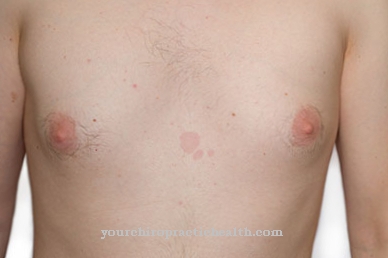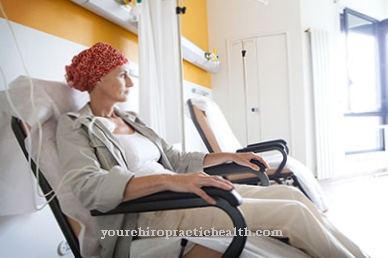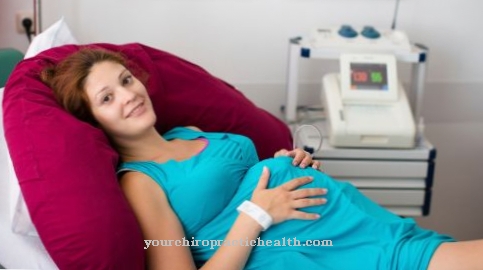A post-traumatic stress disorder can follow traumatic experiences, such as the death of a family member or a serious accident, and then usually set in very quickly after the experience. The therapy concepts are diverse.
What are post-traumatic stress disorder?
.jpg)
© VadimGuzhva - stock.adobe.com
The post-traumatic stress disorder is a mental disorder that can occur in a person as a result of a traumatic situation. A traumatic situation is understood to mean a situation in which the health or life of one's own person or a person close to them is at risk.
Post-traumatic stress disorder can occur at any age and usually starts immediately after a traumatic situation. It is not infrequently the case that a person does not have an isolated post-traumatic stress disorder, but also other psychological problems that occur in addition to a post-traumatic stress disorder (such as depression or anxiety).
Post-traumatic stress disorder manifests itself, for example, in the fact that the person concerned often experiences the traumatic situation repeatedly in thoughts or dreams (one also speaks of so-called flashbacks). Sleep disorders and feelings of threat (e.g. threatened or exercised violence by other people) are also among the symptoms that a post-traumatic stress disorder can bring with it.
causes
The direct cause of a post-traumatic stress disorder developed is participation in a traumatic situation. The traumatic situation that causes a post-traumatic stress disorder can either have been experienced directly by the person or the person concerned was an observer of the situation.
Corresponding traumatic situations would be war experiences or terrorist attacks, serious accidents, rape, hostage-taking or even a message about the unexpected death of a loved one.
Scientific studies also suggest that post-traumatic stress disorder is more common in people who had mental health problems before a traumatic situation, who received little social support, or who had negative childhood experiences.
Symptoms, ailments & signs
Post-traumatic stress disorder can occur shortly after a traumatic experience, but also with a considerable delay. The stressful event constantly recurs in nightmares and sudden scraps of thought (flashbacks), the depressing memories cannot be controlled and largely determine thinking and feeling.
Partial amnesia, in which important details of the trauma are suppressed from consciousness, is also possible. Patients suffer from great fear and helplessness but are unable to talk about it. Physical pain is felt just as strongly as in the traumatic situation.
In order to protect themselves, those affected avoid all situations that could remind them of the experience, they become indifferent to their surroundings and their fellow human beings and become emotionally dull. In addition, post-traumatic stress disorder affects the autonomic nervous system: Signs of vegetative overexcitation can include problems falling asleep and staying asleep, increased irritability, difficulty concentrating and excessive nervousness.
Many patients lose confidence in themselves and others, and feelings of guilt and shame can increase to self-loathing. In everyday life, PTSD leads to massive restrictions that can result in job loss and social isolation. Post-traumatic stress disorder is often accompanied by addictions, depression or other mental illnesses, and existing physical complaints can worsen massively.
Course & diagnosis
_2.jpg)
In medicine there are different manuals that define criteria according to which a post-traumatic stress disorder is diagnosed. The prerequisites for diagnosing a post-traumatic stress disorder are, for example, that a person has been confronted with a traumatic experience and reacts to it with great fear, horror or helplessness.
Further criteria that can indicate a post-traumatic stress disorder are persistent reliving of the traumatic situation, avoidance of topics that affect the traumatic situation, decreased emotional responsiveness or increased nervousness; For example, people who have a post-traumatic stress disorder show increased anxiety, sleep problems, difficulty concentrating or increased irritability.
While post-traumatic stress disorder usually occurs immediately after a traumatic situation, in some cases it can also occur with a time delay.
Complications
The risk of complications in connection with post-traumatic stress disorder increases the longer the treatment is not carried out and depends on the living conditions of the person concerned and his ability to seek help. The high comorbidity of PTSD also plays a role here.
In the case of a chronic course of PTSD, for example, there is increased abuse of substances, especially alcohol or non-prescription drugs. This onset of addictive behavior has the effect that, after a while, physical symptoms are added to the psychological symptoms, which can further intensify the fears of those affected.
In addition, the physical symptoms that result from the body's constant alertness can lead to increased damage to the cardiovascular system, digestion and other chronic diseases. Overall, the susceptibility to disease is higher. Accident victims with PTSD have, on average, longer hospital stays and a higher risk of injury-related complications.
Occurring depression and personality changes often lead to social complications that are expressed in isolation or excessive aggression. The tendency to self-harm is increased, which can extend to suicide. The psychological disorders that occur, above all anxiety disorders and personality disorders, are often a reason for extended therapy.
When should you go to the doctor?
After a traumatic event, you should always speak to a therapist or another person you trust. If post-event nervousness, feelings of indifference, and other signs of PTSD occur, a doctor is recommended. The complaints can be reduced with the support of an expert by dealing with the triggering event. After a trauma or a stressful phase of life, professional advice should be obtained early on, because the earlier a post-traumatic stress disorder is treated, the better the chances of recovery.
People who experience symptoms of PTSD after a serious accident or a violent crime should speak to a psychologist immediately. Other contact persons are the family doctor, a psychotherapist or telephone counseling. If a child shows symptoms of post-traumatic stress disorder, the pediatrician or a child and adolescent psychologist should be contacted first. The expert can help identify the cause, support the person affected in coping with the trauma and, if necessary, prescribe a suitable drug for the symptoms.
Treatment & Therapy
There are several treatment approaches that can take one post-traumatic stress disorder is treated. For example, there is what is known as cognitive behavioral therapy to combat post-traumatic stress disorder. For example, fear management is used as part of this psychotherapeutic measure.
In addition, there are a number of other psychotherapy concepts in psychology that are specially designed to combat post-traumatic stress disorder.
Another method that is used to combat post-traumatic stress disorder is what is known as EMDR (Eye-Movement Desensitization and Reprocessing). Among other things, this method is based on a combination of confronting the person concerned with the stimuli that have caused a post-traumatic stress disorder and very rapid eye movements. The combination should be able to alleviate the severity of the mental illness.
Pharmacotherapy (i.e. therapy with drugs) also has products available that are used against post-traumatic stress disorder. For example, appropriate medication should reduce fears that accompany post-traumatic stress disorder or alleviate depressive symptoms that the disease can also bring with it.
You can find your medication here
➔ Medicines to calm down and strengthen nervesprevention
Because traumatic situations that one post-traumatic stress disorder cause, are very rarely foreseeable and are usually not subject to the control of the person concerned, it is very difficult to take preventive measures against a post-traumatic stress disorder. However, it can be very important that therapeutic care is provided immediately after a traumatic situation in order to be able to prevent a possible post-traumatic stress disorder.
Post-traumatic stress disorder can be treated successfully if the person concerned goes into therapy. Although the symptoms heal in around 50 percent of the sick without professional help, psychotherapeutic care is advisable. In the case of untreated PTSD, what has been experienced cannot be fully processed; the prognoses for the future are worse in this case.
Aftercare
The aftercare treatment is primarily about the future. Follow-up care for PTSD is useful in terms of prevention and future planning for the patient. The sick person is strengthened in his mental state so that future stress does not trigger a second episode of illness.
A chronic course of the disease should be avoided, there is a risk of manifestation in about a third of those affected. In these cases, they have been suffering from the symptoms for years. Follow-up care is necessary to enable the patient to come to terms with what has happened and to restore his quality of life. It is useful so that the person concerned can control his emotions when he is reminded of the stressful events.
At the same time, their social skills should be stabilized and reintegration into their familiar surroundings should be carried out under supervision. If the patient has difficulties reintegrating despite a hospital stay or suffers an unexpected relapse, follow-up support is not only advisable, but essential.
You can do that yourself
Patients with post-traumatic stress disorder can learn emergency measures that can make their everyday lives significantly easier. It can also support the healing process.
Information about your own clinical picture is very important, this should be done by reading appropriate books or guides. The exchange with other affected persons, best in self-help groups, helps to reduce one's own level of suffering. In addition, it can be advised to do extensive exercise. Because sport of any kind helps in particular with sleep disorders and anxiety, which often occur in post-traumatic stress disorder. It is also very helpful to improve your own sleep quality. In special group seminars, procedures can be learned to make it easier to fall asleep and stay asleep.
Patients with post-traumatic stress disorder should avoid addictive substances of any kind in everyday life, as this could lead to a worsening of the clinical picture. Legal drugs such as alcohol or nicotine can also have a negative effect on delaying the healing process.
For PTSD sufferers, it makes sense to involve their own family and, if possible, friends and acquaintances in the disease process. This often requires many explanatory discussions. Patients with post-traumatic stress disorder should learn to look carefully and attentively through the world in the long term, as this is how often completely new characteristics are discovered in oneself. It would also be ideal to let your own creativity run free, for example with a new artistic hobby.




.jpg)






















